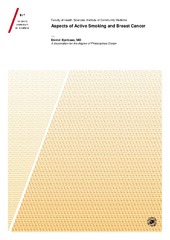Aspects of Active Smoking and Breast Cancer
Permanent link
https://hdl.handle.net/10037/6799View/
Thesis introduction and appendices (PDF)
Bjerkaas E, Parajuli R, Weiderpass E, Engeland A, Maskarinec G, Selmer R, Gram IT: 'Smoking duration before first childbirth: an emerging risk factor for breast cancer? Results from 302,865 Norwegian women', Cancer Causes Control 2013;24:1347-56 (http://dx.doi.org/10.1007/s10552-013-0213-1) (PDF)
Bjerkaas E, Parajuli R, Engeland A, Maskarinec G, Weiderpass E, Gram IT: 'The association between lifetime smoking exposure and breast cancer mortality – results from a Norwegian cohort', Cancer Medicine, Volume 3, Issue 5, October 2014, Pages: 1448–1457 (http://dx.doi.org/10.1002/cam4.304) (PDF)
Date
2014-10-24Type
Doctoral thesisDoktorgradsavhandling
Author
Bjerkaas, EivindAbstract
Summary: According to the WHO, breast cancer is by far the most frequently diagnosed cancer, and the most frequent cause of cancer death among women in the world. Tobacco smoking is the single largest cause of cancer worldwide and has been linked to cancer in most organ systems. The aim of this thesis was to illuminate the association between smoking and breast cancer incidence, mortality, and to study the socioeconomic consequences of smoking-associated breast cancer in a large Norwegian cohort with a high number of female smokers. In Paper I we investigated the association between active smoking and breast cancer incidence. We found an increased risk of 15% for ever smokers overall, as well as an increased breast cancer risk with increasing number of cigarettes smoked per day, smoking duration, number of pack-years smoked, and lower age at smoking initiation. We found an increasing risk with longer smoking duration before first childbirth, and no increased risk among those who started to smoke after first childbirth. In Paper II we investigated the association between smoking and breast cancer mortality, which revealed a 15% increased risk of breast cancer mortality for ever smokers. Most of the results for the different smoking exposures considered were not statistically significant. In Paper III, we used level of education as a validated measure of socioeconomic status, and investigated whether level of education had an impact on the risk of smoking-associated breast cancer. We did not find an increased risk of smoking-associated breast cancer in women with high level of education, but we were able to confirm that smoking before first childbirth remains a risk factor for breast cancer, regardless of educational achievement. Smoking-associated breast cancer does not seem to have an important impact on social inequalities in health. Active smoking, in particular active smoking before first childbirth, emerges as a risk factor for breast cancer incidence.
Description
Paper 3 of the thesis is not available in Munin:
3. Bjerkaas E, Parajuli R, Engeland A, Maskarinec G, Weiderpass E, Gram IT: 'Social inequalities and smoking-associated breast cancer – results from a prospective cohort study', submitted manuscript.
3. Bjerkaas E, Parajuli R, Engeland A, Maskarinec G, Weiderpass E, Gram IT: 'Social inequalities and smoking-associated breast cancer – results from a prospective cohort study', submitted manuscript.
Publisher
UiT The Arctic University of NorwayUiT Norges arktiske universitet
Series
ISM skriftserie; 153Metadata
Show full item recordCollections
- Doktorgradsavhandlinger (Helsefak) [770]
- ISM skriftserie [161]
Copyright 2014 The Author(s)
The following license file are associated with this item:


 English
English norsk
norsk
